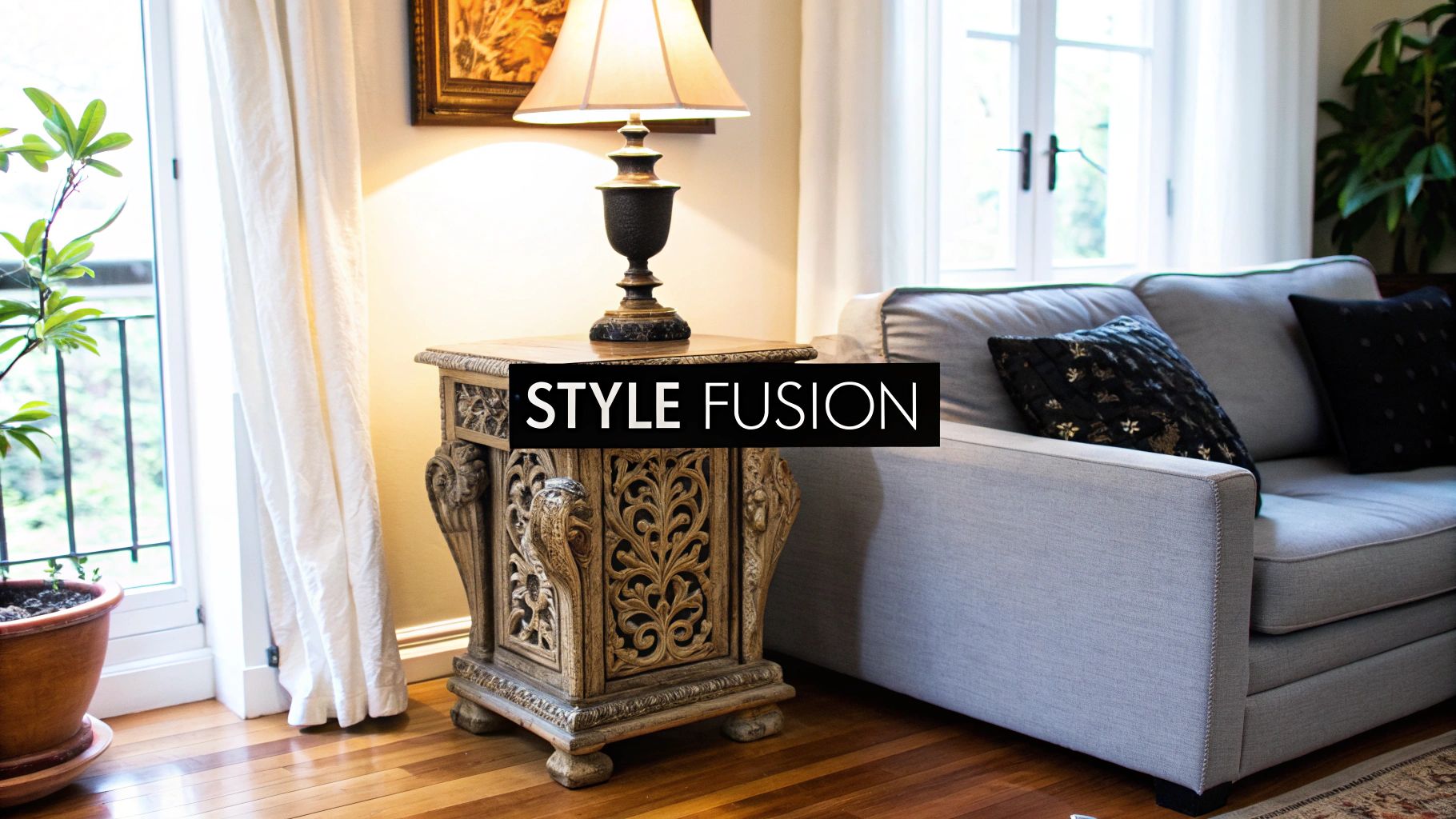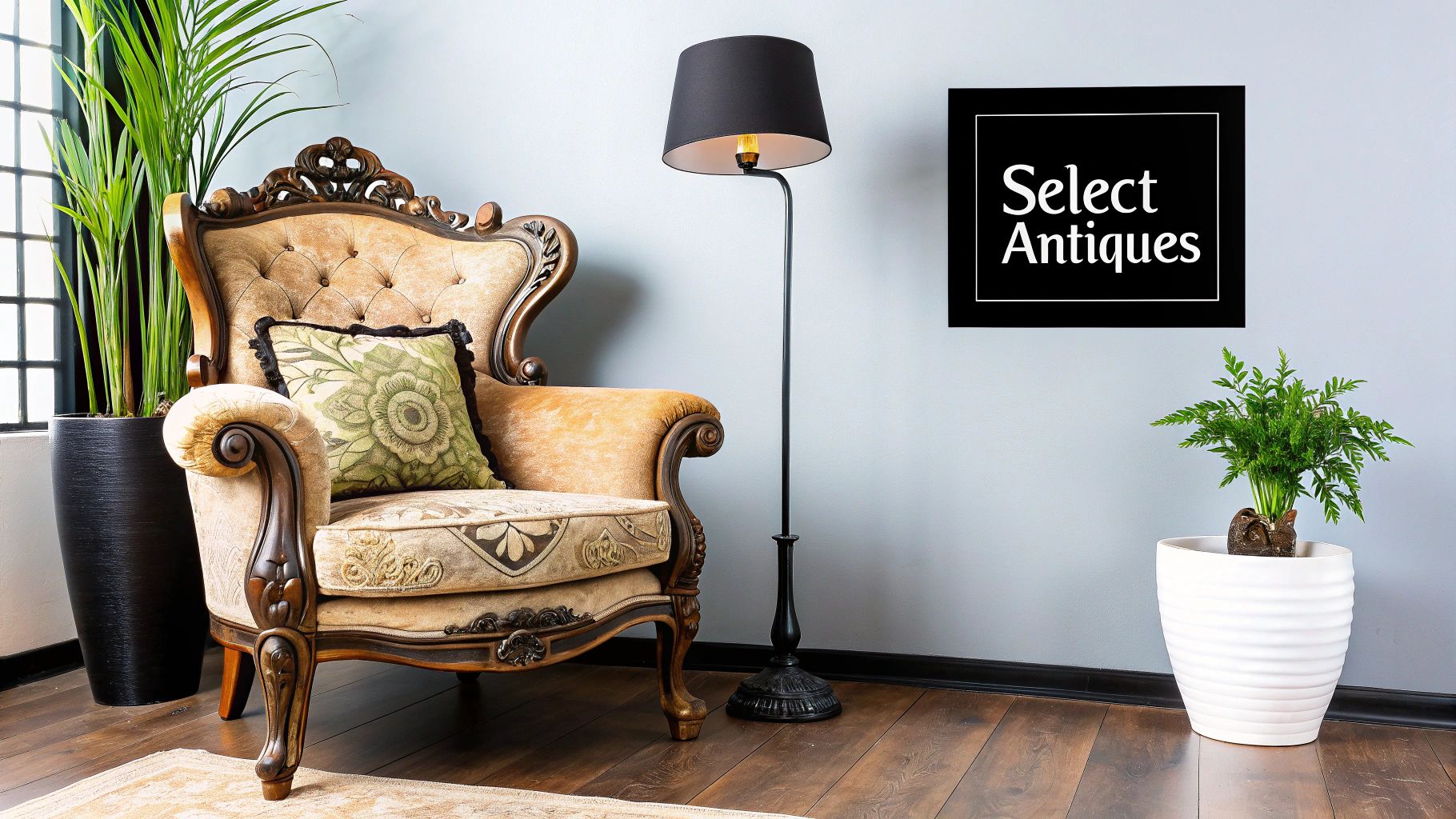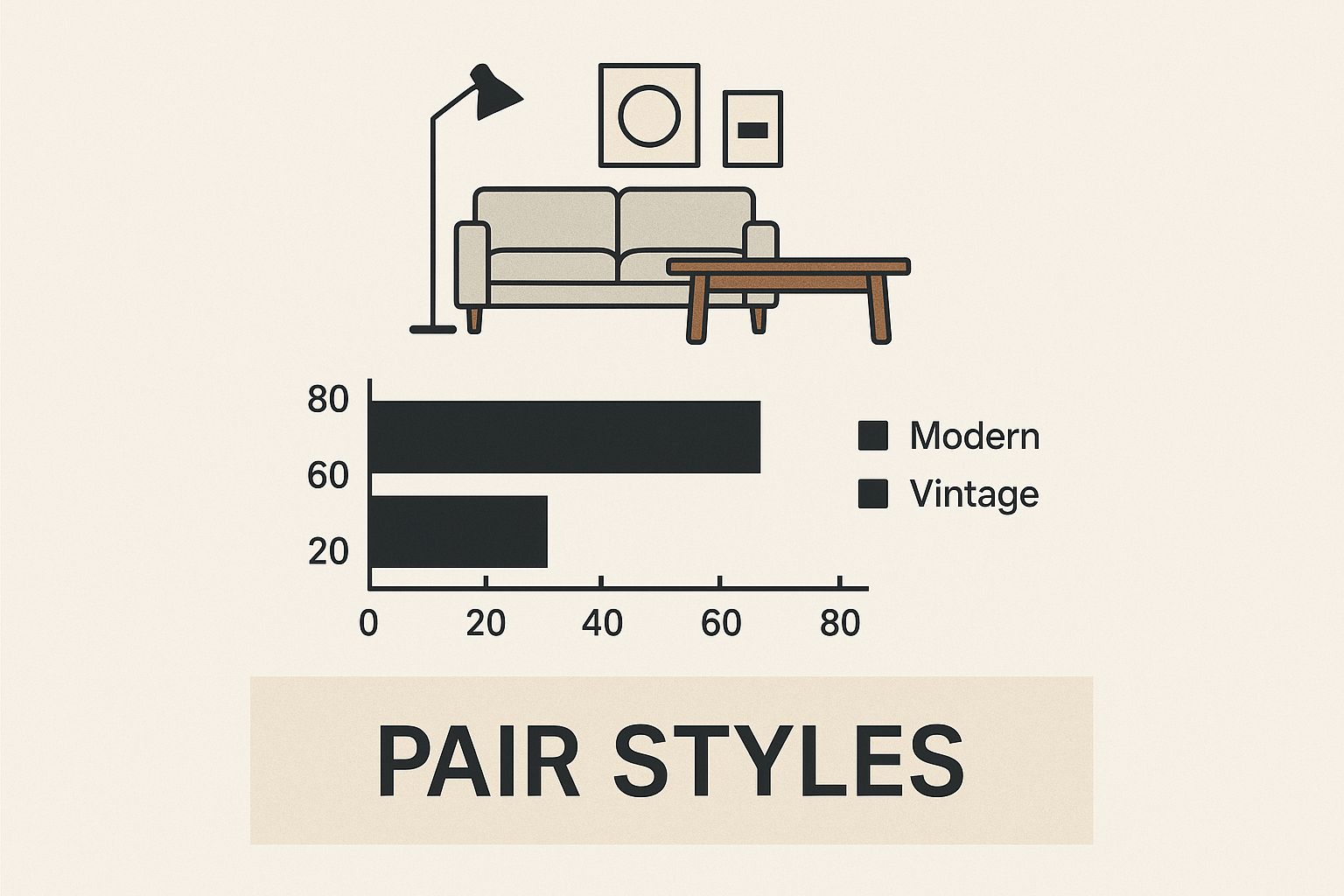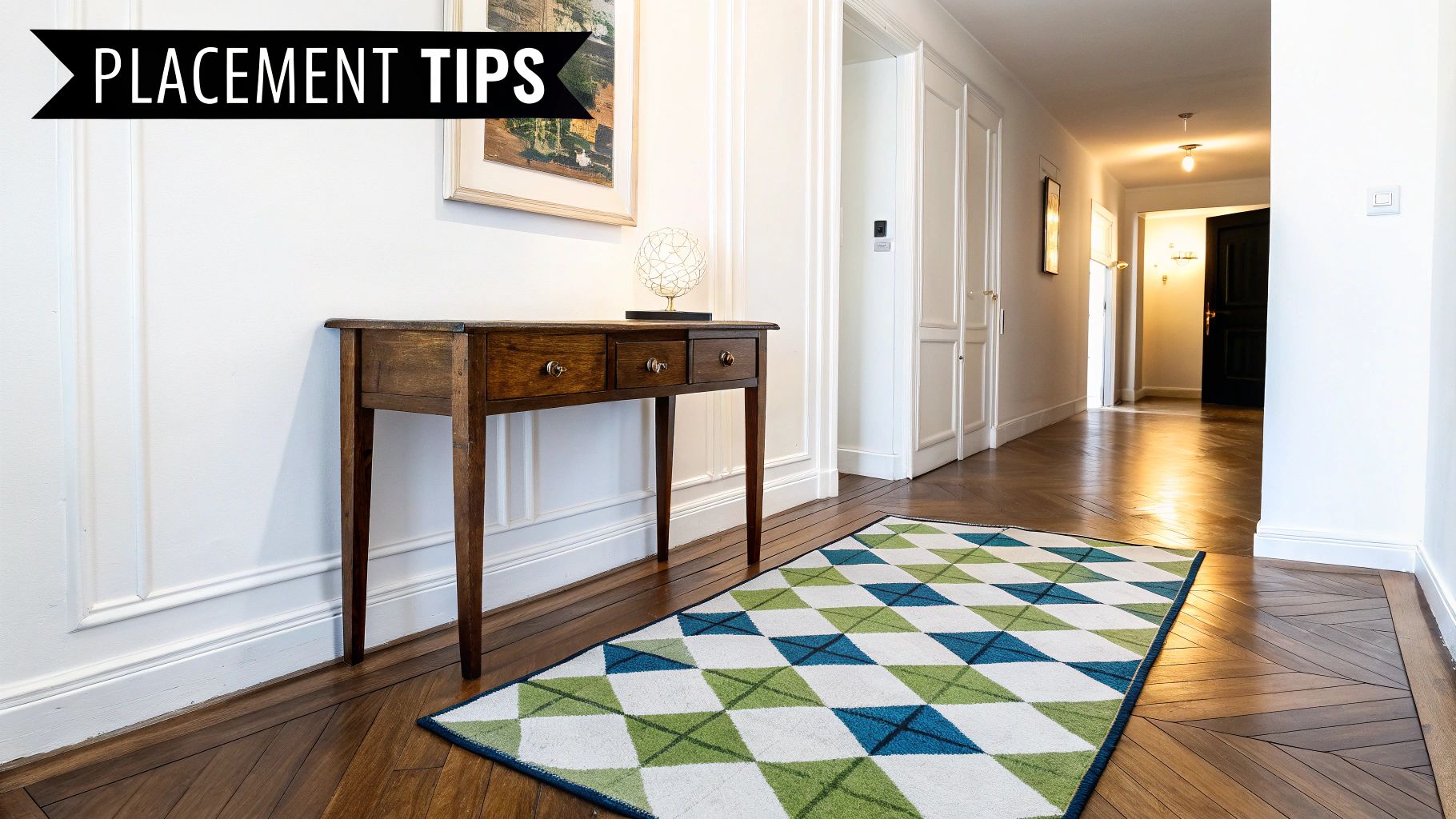20 Inspiring Living Room Layout Ideas for 2025
05.10.25

Mixing modern and antique furniture isn’t just a passing trend; it’s a way to design a space that truly reflects your personality. It’s like curating a personal collection of pieces, each with a story to tell. Blending the sleek lines of contemporary design with the history and craftsmanship of antique pieces creates a home that feels both stylish and personal. This curated approach adds depth and character, something that rooms furnished solely with modern pieces often lack.
The magic lies in the contrast. Modern furniture often emphasizes clean lines, functionality, and a minimalist aesthetic. Antique furniture, conversely, brings a sense of history, intricate details, and often, a unique story. This contrast creates visual interest and a dynamic tension that draws the eye. Imagine a sleek, modern sofa paired with an antique, ornately carved coffee table. The unexpected combination highlights the beauty of both pieces. Furthermore, mixing eras offers a more sustainable approach to decorating. Choosing pre-owned antique pieces reduces the demand for new furniture, lessening the environmental impact. This resonates especially with younger generations who value sustainability. This growing trend has also revitalized the antique market, with dealers seeing a surge in interest, particularly for pieces that blend seamlessly with modern elements. Learn more about these trends here: Trends in Antique Furniture Collecting
Successfully mixing modern and antique furniture hinges on finding common ground between the pieces. This could be a shared color palette, similar materials, or complementary shapes. A mid-century modern chair, with its clean lines, pairs beautifully with an antique side table in a similar wood tone. This creates a subtle link between the pieces, despite their different origins.
To help illustrate the advantages of this design approach, let’s look at a table summarizing the key benefits:
This table highlights the key advantages of combining furniture from different eras in your home design.
| Benefit | Modern Furniture Contribution | Antique Furniture Contribution |
|---|---|---|
| Visual Interest | Clean lines, simple shapes provide a neutral backdrop | Ornate details, unique carvings add focal points |
| Depth and Character | Minimalist aesthetic offers a sense of calm | Rich history and patina create a sense of story |
| Sustainability | Choosing fewer new pieces reduces environmental impact | Reusing existing pieces supports a circular economy |
| Personal Expression | Reflects current tastes and preferences | Showcases appreciation for history and craftsmanship |
| Cost-Effectiveness | Offers a range of price points | Can be a more affordable alternative to buying all new pieces |
This combination of old and new offers a unique way to express personal style while contributing to a more sustainable approach to interior design. The blend provides a compelling mix of visual interest, historical significance, and environmental consciousness.
By considering these elements, you can create a visually appealing and harmonious space. The goal isn’t to recreate a museum, but rather a living space that feels collected, comfortable, and uniquely you. This blend lets you create rooms that are both nostalgic and contemporary, adding a distinctive touch.

Mixing modern and antique furniture can be intimidating. Many people worry about accidentally creating a cluttered look. However, understanding a few key design principles can make all the difference. These principles act as guidelines, helping you blend styles for a harmonious and visually appealing space.
One effective way to create harmony is to identify connecting elements. These are shared characteristics between pieces, such as color, material, or shape.
For instance, a modern sofa with clean lines could pair beautifully with an antique coffee table if they share a similar wood tone or metal finish. This shared element creates a visual link, bridging the gap between eras. It brings a sense of cohesion without being too matchy. You might be interested in: How to master mixing furniture styles
Visual weight is another crucial aspect of mixing furniture styles. Imagine a seesaw: you need balance on both sides for stability. A large, ornate antique armoire naturally carries more visual weight than a sleek, minimalist modern chair.
To balance this, consider pairing the armoire with other substantial modern pieces, or group several smaller modern items together. This prevents the antique piece from dominating the room, maintaining a sense of balance. Understanding visual weight allows you to create a dynamic yet grounded space.
Finally, don’t underestimate the power of negative space. This refers to the empty areas around your furniture. Negative space is vital in a room with mixed furniture styles, allowing the eye to rest and preventing a cluttered feel.
Adequate negative space also highlights individual pieces, showcasing their unique features. Avoid overcrowding the room. Give each piece breathing room, allowing it to contribute to the overall aesthetic. By strategically using negative space, you can create a cohesive and engaging room.

The increasing popularity of mixing modern and antique furniture isn’t simply a fleeting design trend. It signifies a deeper shift in consumer behavior and market dynamics, influencing how we furnish our homes and perceive furniture’s value.
Millennials and Gen Z, now dominant consumer groups, are at the forefront of this change. They value sustainability, individuality, and lasting quality. This has fueled the growth of the resale market and a renewed appreciation for antique and vintage furniture.
These generations view furniture as an investment, not a disposable commodity. They actively seek out unique antique pieces to blend with modern furnishings, creating a personalized aesthetic. This has led to a surge in demand for vintage and antique items, prized for their character and history.
Today’s homeowners are increasingly viewing furniture as a long-term investment rather than a short-term purchase. This mindset prioritizes well-made pieces, both new and antique, built to endure.
Mixing modern and antique furniture becomes a way to build a collection of enduring value. Combining modern durability with antique craftsmanship creates a timeless aesthetic while ensuring pieces last for generations.
Recent supply chain challenges have also contributed to the growing interest in vintage furniture. When new furniture faced long lead times, readily available vintage pieces became a desirable alternative, offering both immediate gratification and unique style.
Furthermore, the increasing emphasis on sustainability plays a crucial role. Choosing pre-owned furniture aligns with eco-conscious values by reducing consumption and giving existing pieces new life.
This trend is mirrored in the broader furniture market, which is experiencing significant expansion. For more in-depth market analysis, see the United States Furniture Market Research. Globally, the market is growing, with the U.S. furniture market projected to reach $250.9 billion by 2033, a CAGR of 3.1% from its $189.8 billion value in 2024. This growth is driven by increased residential construction and remodeling, bolstering demand for both new and vintage pieces.
Certain mixed furniture styles command premium resale values. Well-preserved, high-quality antique pieces, especially those from recognized periods or designers, retain their value remarkably well. The data chart below illustrates the average resale value increase for select furniture styles over a five-year period.
| Furniture Style | Resale Value Increase (%) |
|---|---|
| Mid-Century Modern | 15% |
| Art Deco | 12% |
| Victorian | 8% |
| Industrial | 10% |
This chart demonstrates that Mid-Century Modern furniture leads in resale value appreciation, followed by Industrial and Art Deco styles. This highlights the investment potential of incorporating these styles with contemporary pieces.
By strategically integrating these sought-after styles, homeowners can curate stylish interiors that appreciate in value over time. This approach combines aesthetic enjoyment with financial prudence, contributing to the continued popularity of mixed-era interiors.
Let’s explore what motivates consumers to embrace this blend of old and new. The following table summarizes key drivers behind the trend of mixing modern and antique furniture.
Consumer Motivations for Mixing Furniture Styles
This table presents key factors driving consumers to combine modern and antique pieces in their homes.
| Motivation Category | Specific Driver | Percentage of Consumers |
|---|---|---|
| Financial | Investment Value | 45% |
| Affordability (Mixing high-value antiques with budget-friendly modern pieces) | 25% | |
| Aesthetic | Unique Style | 60% |
| Creating a Personalized Look | 55% | |
| Ethical | Sustainability | 30% |
| Reducing Consumption | 20% |
This data reveals that the desire for a unique and personalized aesthetic is the primary motivator, followed by the financial benefits of mixing furniture styles. Sustainability also plays a significant, though smaller, role. This reinforces the idea that consumers are not just looking for beautiful homes but also for ways to furnish them responsibly and economically.
Mixing modern and antique furniture isn’t simply about aesthetics. It’s a conscious choice, a way to embrace sustainable living and express your unique style. By incorporating pre-owned pieces into your home, you significantly reduce your environmental impact, a growing concern for many homeowners today.
Manufacturing new furniture consumes considerable resources and energy, resulting in a substantial carbon footprint. Opting for antique and vintage furniture offers a sustainable alternative. It diverts these often-forgotten treasures from landfills, minimizing waste and contributing to a circular economy. This practice lessens the demand for newly produced goods, which can involve resource-intensive processes.
Transporting new furniture, frequently over long distances, also adds to its environmental toll. Sourcing local antique and vintage pieces further reduces your impact by supporting a more localized and sustainable furniture ecosystem.
Whether you’re considering new or vintage furniture, evaluating its sustainability involves several key factors. Begin by examining the material sourcing. Seek out pieces made with sustainably harvested wood, recycled materials, or low-VOC finishes. These choices minimize environmental harm during both production and use.
Next, consider the piece’s expected lifespan. Durable, well-made furniture, regardless of its age, reduces the need for frequent replacements. This longevity minimizes long-term environmental impact and supports a more sustainable lifestyle.
Finally, assess the potential for repair and restoration. Antique furniture, typically crafted with high-quality materials and meticulous joinery, lends itself well to repair and restoration, potentially extending its life for generations. This repairability significantly reduces waste and preserves the value of these unique pieces. The increasing popularity of antique and vintage furniture has fostered a thriving resale market. This market expands 21 times faster than traditional retail, with specific styles like Gustavian furniture experiencing a 45% sales increase, fueled by environmentally conscious Gen Y and Gen Z consumers. Discover more insights about the growing antique market.
Mixing modern and antique furniture allows you to curate a home that transcends fleeting trends. It fosters a sense of permanence and allows you to resist the constant pressure of replacement cycles driven by fast furniture trends. Investing in quality pieces, whether new or antique, creates an interior that truly reflects your personal style while safeguarding both your investment and our planet’s resources.
While preserving antique furniture is crucial, it’s equally important to adapt it to your modern lifestyle. Repurposing antique pieces for contemporary use, like converting an antique dresser into a bathroom vanity, blends the charm of the old with the functionality of the new. This balance of preservation and practicality creates a sustainable and stylish living environment. By embracing thoughtful furniture mixing, you create a home that reflects your values and contributes to a more sustainable future.

Mixing modern and antique furniture successfully takes a room-by-room approach. Each space has its own unique opportunities and challenges. This means thinking about the room’s function and how different furniture styles can enhance its purpose and overall aesthetic.
The living room, often the heart of the home, thrives on the warmth and character of antique furniture. An antique sofa can become a striking centerpiece. Pairing it with modern accent chairs and a sleek coffee table creates a balanced, inviting space.
When using antique furniture in a living room, consider its scale and proportion. A large antique armoire might overwhelm a small room, while a delicate antique side table might get lost in a larger, more open space. Check out our guide on finding the right furniture for every room.
Dining rooms offer a great chance to blend the elegance of antique furniture with modern design’s functionality. An antique dining table, perhaps with intricately carved legs, instantly adds sophistication.
Pairing it with modern, comfortable dining chairs ensures practicality. This contrast creates a space that honors tradition while meeting contemporary needs.
The bedroom benefits from mixing furniture styles. An antique bed frame adds a touch of romance and history. An ornate Victorian bed frame paired with modern nightstands and a sleek dresser creates a balanced, calming sanctuary.
This approach creates a personal retreat reflecting individual style and a connection to the past. Choose furniture that promotes relaxation and restful sleep.
Integrating antique furniture into a modern home office can be challenging, especially concerning technology. An antique desk might not easily accommodate modern technology.
This means creatively integrating these necessities. Using cable management systems and wireless peripherals minimizes visual clutter. Modern task lighting complements the workspace. This creates a functional and inspiring workspace.
In smaller homes, using substantial antique pieces requires considering scale. A large antique piece can easily overwhelm a small space. Choose antique pieces strategically.
A large antique mirror can create the illusion of more space. Smaller antique accents, like a vintage side table, can add character without dominating the room. The goal is balance between old and new while maintaining spaciousness. This allows you to enjoy the character of antique furniture even in compact living areas.
Mixing modern and antique furniture begins with finding the right pieces. This requires a discerning eye, patience, and some insider knowledge. This section will give you the skills to find quality pieces without overpaying or inheriting a costly restoration project.
Whether you’re admiring a mid-century modern credenza or an antique Victorian settee, understanding quality construction is essential. Look for solid wood construction in antique pieces, dovetail joinery, and signs of hand-craftsmanship. For example, hand-carved details or intricate inlays often indicate a higher quality piece.
However, be aware of red flags. These might include wobbly legs, significant veneer damage, or evidence of extensive, poorly done repairs. These issues can be expensive to fix and could diminish the piece’s value.
While antique malls and flea markets are common starting points, consider exploring less conventional sourcing channels. Estate liquidation services can be a goldmine of unique finds. Regional auction houses, many with online bidding options, often offer competitive prices.
Additionally, online marketplaces like eBay can connect you with sellers across the country. Just be sure to carefully check the seller’s reputation and ask for detailed photographs before committing to a purchase. You might be interested in: Exploring different furniture categories.
The market offers both modern reproductions of antique styles and authentic antiques. Both can have a place in a mixed-era interior. When evaluating reproductions, carefully examine the quality of materials and construction. For authentic antiques, inquire about the piece’s provenance and any restoration work that has been completed.
Negotiating is standard practice in the antique and vintage furniture market. Start by researching similar pieces to determine a fair market value. Then, approach the seller with a reasonable offer. Be willing to walk away if you can’t reach a price that works for both of you.
Once you’ve found the ideal piece, think about transportation logistics. For delicate items, professional movers specializing in antique furniture are a good idea. They possess the experience and tools to handle fragile items securely.
For smaller items, ensure sufficient padding and safe transport to prevent damage during the trip. Careful planning ensures your treasures arrive home undamaged, ready to enhance your mixed-era decor.
Ready to elevate your home with timeless, high-quality furniture? Browse a unique collection of pre-owned pieces at High End Used Furniture. Discover special finds and begin designing your dream space now!
High end used furniture